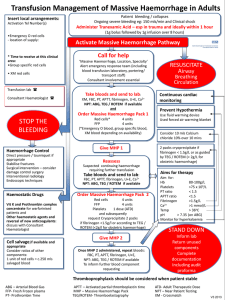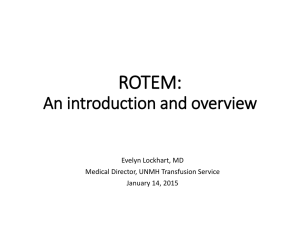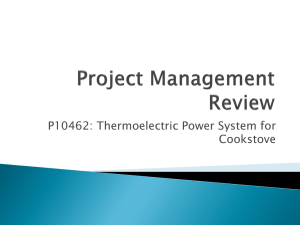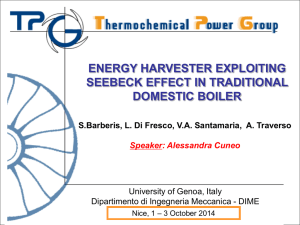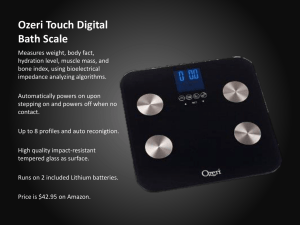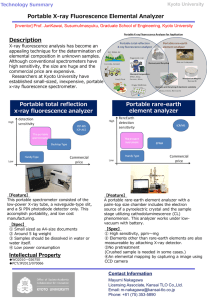Lab CVOR Deficiencies of 2010 and New Technologies
advertisement
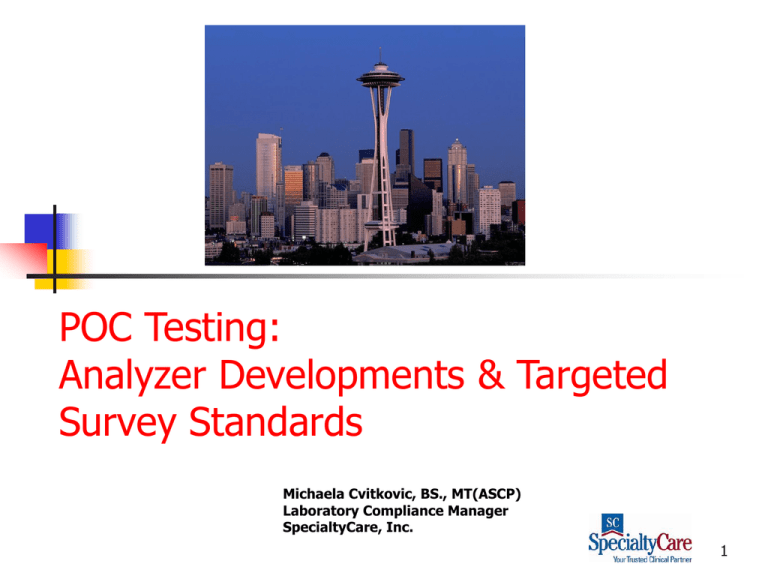
POC Testing: Analyzer Developments & Targeted Survey Standards Michaela Cvitkovic, BS., MT(ASCP) Laboratory Compliance Manager SpecialtyCare, Inc. 1 ANALYZER COMPARISONS & DEVELOPMENTS Blood Gases: epoc & iSTAT1 Bleeding Management: ROTEM delta & TEG 5000 New Developments Quality Control POC analyzer 2 CVOR POC Lab Deficiencies Competency Credentialing Q.C. Failures Temperature Controlled Spaces 3 Top Deficiencies Cited by JCAHO and CAP 4 COMPETENCY & the NEW employee Must complete an Initial Training, before patient testing Must complete semi-annually competency during the first year of duties, by 6 months Continue with current staff on an annual basis 5 COMPETENCY New Equipment – “non-waived” testing Retain Original Training Documents!! Implementation of new methodologies must have documentation of Initial Training (i.e. iSTAT1 to Gem3500). Even if the analyzer is an upgrade must retain original training material (i.e. iSTAT 200 to iSTAT1 – Signature Plus to Elite). Save this documentation as long as the analyzer is available for patient testing. 6 CREDENTIALS Testing Personnel Limitations Perfusion Certification is not a “CLIA defined eligibility route” – may be asked to produce H.S. Diploma Know who is permitted to be classified as Testing Personnel. For example, in CA – Perfusionists are exempt from the lab licensing for patient testing, but staff like Perfusion Assistants or Anesthesia Technicians, are not. 7 QUALITY CONTROL Failures If have a ‘wet’ failure on an analyzer that uses EQC, carefully determine C.A. before proceeding. Do not continue to repeat ‘wets’ until get one in-range! Two consecutive ‘wet’ failures in a row will trigger a repeat of the 10 or 30 day EQC study – depending on the analyzer. 8 TEMERATURES Refrigerator & Room If supplies (cartridges, QC) are being stored in a small local (O.R.) Refrigerator, there must be indication of temperature monitoring. CAP requires daily. If Refrigerator is not hard wired to Engineering or continuously monitored in some manner, must be manual documentation. If have supplies kept at Room Temp, such as cartridges, should have a monitoring system also. 9 TEMERATURE Documentation • • acceptable range - C or F must be consistent - tightest range in use, (iSTAT 18-30 RT while Gem Cart 15-25) daily temp in addition to Min/Max – Daily is specified in CAP Checklist standards! • area for corrective action • explanation of date w/out temp recorded • monthly review w/ date & initials 10 ANALYZER COMPARISON – POC Blood Gas 11 Epocal epoc® System distributed by Alere Reader Host Test Card 12 Epocal epoc System ® Common features vs. comparable POC analyzer: – – – Single-use, self-calibrating, 95 mL WB sample Blood gases, electrolytes, metabolites and hematocrit on a single cartridge Data management 13 epoc system Unique features vs. comparable POC analyzer: up to 6-month Room Temp shelf-life from date of manufacture bar coded cards read on insertion 14 epoc vs. iSTAT1 Room Temp storage only 1pt cal before sample added, 165 sec ( 2.75 min ) Room Temp cart storage for 2 wks 1 pt cal w/ sample upon cart. insertion 35 secs 130-200 secs sample only Cal & sample processing Separate ABG, Lytes, Metabolite & Hct QC vials Available Eurotrol QC ABG, Lytes, Metabolites & Hct one vial 15 epoc vs. iSTAT1 Notification of update via e-m and installation from EDM via WiFi epoc analyzer = Reader & Host - Multiple Readers w/ 1 Host Updates mailed 2x/yr self-installed Analyzer all inclusive 16 epoc vs. iSTAT1 Cart read upon insertion; each individually bar coded BGEM: pH, pCO2, pO2, Na, K, iCa, Glucose, Lactate, Hct Only cartridge is BGEM Reader = Lithium Ion rechargeable battery only Each cartridge pouch manually scanned CG8+ (No Lactate) Multitude of cartridge configurations Rechargeable or Disposable batteries 17 epoc vs. iSTAT1 Automated Internal QC ( iQC ) - No External Sim. Host display “Windows”-like Internal QC & also External Simulator Basic text display 18 epoc Future Developments as related to CVOR: Coag: ACT, PT, aPTT Creation of single-vial QC to contain ABG, Lytes, Metabolites & Hct 19 New development in QC Eurotrol QC “one ampule all analytes” ABG, Lytes, Metabolites & Hct in one vial 20 Eurotrol QC Hyperbaric X-High 710 mmHg 21 Eurotrol QC Hypoxic X-Low 15 mmHg Generic for all blood gas analyzers – one range fits all 22 Eurotrol Hyper & Hypoxic HYPER – – published ranges for iSTAT use on any ABG analyzer, but must establish In House ranges HYPO – one published range for all analyzers 23 ANALYZER COMPARISON – Bleeding Management 24 ROTEM®delta 25 ROTEM®delta System Thromboelastometry 1600 units in clinical use in 50 countries more than 500 publications 26 ROTEMdelta System Common feature vs. comparable analyzer is the analysis platform: Clot formation, strength & stability, and subsequent lysis. 27 ROTEM® vs. TEG 5000® GENERAL INFO – Incorporated in July 2008 – Primarily targeted researchers at the start – 2-test approval 3/23/10, in-tem & hep-tem – Additional 3 tests approved 8/12/11 – April 2000 Haemoscope received the 510K – Purchased by Haemonetics 11/21/07 – 5 tests with different activators 28 ROTEM vs. TEG 5000 PRINCIPLE Rotational Thromboelastometry trademarked by Rotem Principle: pin oscillates as the cup remains stationary & as clot forms rotation becomes restricted & clot firmness detected optically Classical or ‘Original’ method: Thromboelastography – originally described by H. Hartert in 1948 & trademarked by Haemoscope. Principle: cuvette is rotated and as clot forms it links the pin & cup together; movement of the pin is converted to electrical signals 29 ROTEM delta & TEG 5000 PRINCIPLE via graphics Rotating axis (+/ - 4.75°) Spring Light source Detector Ball bearing Plastic pin Cuvette with blood Fibrin strands and platelet aggregates between surfaces Heated cuvetteholder Cup takes 10 seconds per rotation Electrical detection Pin makes 13 oscillations per minute Optical detection 30 ROTEM vs. TEG 5000 COMPONENTS Control unit integrated 4 channel instrument Control unit on separate PC 2 channel instrument Up to 8 channels can run on one PC Scan can be viewed remotely using Secure Viewer software No leveling required (constant monitoring system) Scan can be viewed remotely Some leveling required 31 ROTEM vs. TEG 5000 COMPONENTS Automated pipette Touch screen monitor Temp can be adjusted for Hypothermia Manual pipetting N/A (unless computer is set up as such) Temp can be adjusted for Hypothermia 32 ROTEM vs. TEG 5000 QUALITY CONTROL ROTROL N and ROTROL P EQC Option 2 – Aqueous QC’s once/week Continuously monitors: Phase Shift, Variance, Center, Amplitude, Temperature Level I and II QC Aqueous QC’s every 8 hours of patient testing No continuous monitoring, however eTest verifies and/or maintains the electronic functioning of the analyzer 33 ROTEM vs. TEG 5000 REGULATORY Both have available Proficiency Testing with CAP & API TEG5000 also has PlateletMapping Proficiency Testing with CAP CMS reimbursement available 34 ROTEM vs. TEG 5000 SAMPLE PREP Once draw into Citrated tube, sample can be run immediately, or up to 4 hrs later. Citrated samples – must sit for at least 15 min, but run within 2 hours Non-Citrated samples – must be run within 4-6 minutes 35 ROTEM vs. TEG 5000 TEST MENU in-tem® hep-tem® NATEM® intrinsic pathway in citrated whole blood specimens the intrinsic pathway in the presence of unfractionated heparin, in citrated whole blood specimens (open heart) research and less clinical practicality - Kaolin activator, Citrated sample - Kaolin activated, non-Citrated - Kaolin activator, Citrated sample, in Blue Heparinase cup - Kaolin activated, non-Citrated s. in Blue Heparinase cup - Non-activated, Citrated sample - Non-activated, non-Citrated s. 36 ROTEM vs. TEG 5000 TEST MENU Rotem tests approved 8/12/11 ex-tem® hemostasis via the extrinsic pathway fib-tem® measuring fibrinogen contribution to the clot ap-tem® detects hyperfibrinolysis RapidTEG, (TEG-ACT) non-citrated or citrated Research protocols using Tissue Factor alone Functional Fibrinogen non-citrated or citrated LY30 and lysis parameters in all TEG assays 37 ROTEM vs. TEG 5000 TEST MENU N/A Platelet function PlateletMapping® Assay - Activator F - ADP (tests for GPIIb/IIIa receptors) clopidogrel, etc - Arachidonic Acid (test for aspirin and other NSAIDs) N/A No anticoagulant or activator (liver transplants) Native, non-activated non-anticoagulated or citrated 38 ROTEM vs. TEG 5000 DECISION TREE ROTEM - Does offer on-line FUZE Training. Data Interpretation using PowerPoint Presentation. - Discuss temogram interpretations. 39 TEG 5000 - Scan 40 ROTEM® - Screenshot Lysis ML (%) A20 = Clot Firmness (mm) 20 minutes after CT Clot Quality 41 ROTEM vs. TEG 5000 SCAN PARAMETERS CT - Clot Time, (seconds) CFT – Clot Formation Time (seconds) α Angle – Alpha Angle, (°) A (x) – Amplitude at a time point (minutes) 10/15/20/25/30 mm MCF – Maximum Clot Firmness, (mm) R = Reaction time, (minutes) Time to initial fibrin formation K = Coagulation time, (minutes) Speed of fibrin build up a = alpha angle, (°) Speed of clot strengthening No equivalent parameter MA = maximum amplitude, (mm) Strength of clot 42 ANALYZER WITH PENDING FDA SUBMISSION & APPROVAL 43 HELENA ABRAZO Must stress For Investigational Use Only at this time FDA Submission in Sept 2011 Tests to be submitted for FDA Approval: aPTT, PT & Celite ACT Watch for further developments Specific contents of this slide approved by Helena 44 ~ THANK YOU ~ Michaela.Cvitkovic@specialtycare.net Abbott / iSTAT 800-827-7828 www.abbottpointofcare.com Epocal Inc 888-893-6225 www.epocal.com Eurotrol, Inc. 866-234-5754 www.eurotrol.com Helena 888-893-6225 www.helenapoc.com Rotem 919-941-7777 www.rotem.de 45

